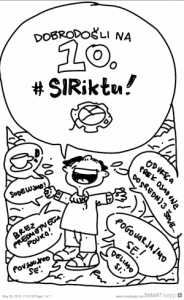Lea Červan, I. osnovna šola Celje, Celje
In the context of the science day dedicated to measurement, we give a lesson on the observation of collision and bouncing. Pupils get instructions as to what needs to be measured and which devices can be used, but they choose the path to the goal by themselves. They use their mobile phone camera to help them read the measurements. They carry out the experiments with great diligence, creativity and collaboration within the group. The main goal of the lesson is to encourage the creative work of pupils. It allows them to use technology as a tool in carrying out experiments. Pupils get used to working in a group. At the same time, they revise the topic of measurement errors and get experience with collisions and bouncing of bodies. Pupils’ first encounter with the bouncing and collisions of bodies can be linked with the treatment of measurement errors. In carrying out the experiments, we ran into a problem of how to accurately read altitude rises as the pendulum bounces off. The ball travels fast, and pupils have failed to detect the height of the lift. I decided to use a mobile phone camera, and pupils were impressed by the way the experiment was carried out. To view the recordings, pupils used the slow motion playback. Measurements were more accurate, and pupils were very motivated to work. During the introductory lesson, I show pupils how to calculate the average value, the absolute error and the relative error. In groups, they measure the length of the classroom. Pupils come up with their own way of measuring the length and then calculate the measurement error. During the second lesson, pupils observe the collision of two balls. Groups have different balls: two wooden balls, a wooden and a table tennis ball, and a wooden a putty ball. Each group measures the average height of bouncing balls if the wooden ball is released from the height of 5 cm. Pupils attach pairs of balls onto racks. To help them measure the height of the bouncing balls, they use checkered A3 paper, which allows the measurement of the rising balls, and mobile phone cameras, which allow for pinpoint measurements. Pupils note down five successful measurements and then calculate the average height of bouncing balls and the measurement error. The groups compare their measurement results. We could play the best video of each group and compare the videos while thoroughly analysing them, but this is a task for the following school year.
